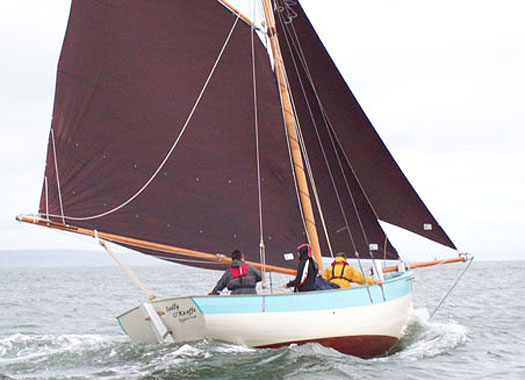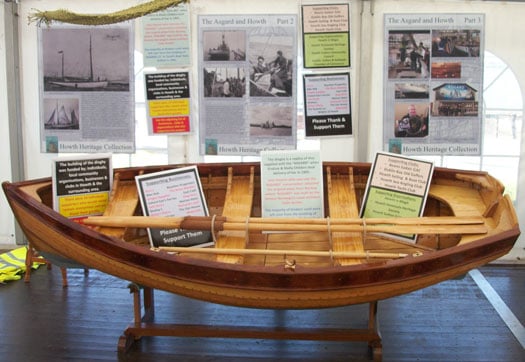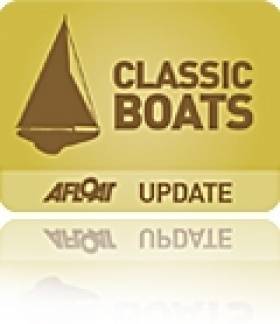Displaying items by tag: Boat Building
Limerick's Boat Building Tradition Enters New Phase With 'City One' Dinghy Launch
#cityone – Limerick's long tradition of boat building has entered a new phase with the innovative 'City One' design from the Ilen school and network for wooden boat building taking to the water this weekend writes Andrew Carey.
The school, which has built the traditional Gandelows, took inspiration from the traditional Shannon river boat to design the new 'City One' and have it ready for the annual festival of racing on the river.
"The City One is designed for the River Shannon and the city. Limerick has the biggest number of tides in the country and the river demands a dynamic boat and these boats have been designed with that in mind," explained project co-ordinator, Gary Mc Mahon.
Gandelow Races start at 1.30pm this Saturday from Howley's Quay, Limerick City Centre and the organisers are hoping for a fine day for the spectators but a good wind to show the boats at their best.
This year's Gandelow Races include the special 'City One' Limerick sailing challenge, which involves the launch and racing of four of the new and spectacular performance sailing boats, designed for racing between the bridges of Limerick and custom-built at the Ilen School in Roxboro, a Limerick City of Culture #madeinlimerick legacy project.
"In essence, spectators can expect to see dynamic and highly competitive river rowing and sailing - rowing, in the racing of Limerick's unique and elegant traditional fishing-boat," said Gary.
The races this year have entries from familiar and popular teams, coming from the city and beyond - with competition is heating up between the Limerick City and County Clare teams.
The 'City One' races will be held in association with Lough Derg Yacht Club and will have experienced teams competing in an exciting and challenge race format.
The new boats will also be on view on Culture Night (this Friday) at Howleys Quay and there will be yet another opportunity to see them at an exhibition to be launched on September 26 in St Mary's Cathedral, as the 'City One' sail boat decoration was the subject of an international graphic design competition.
#woodenboat – The wonderful world of Ireland's wooden boats is a winding trail. W M Nixon went to West Clare to see one boat, but unexpectedly happened upon another with which he was totally smitten. Then he found the original objective of his travels was even better than expected. And finally back home, he found the project to re-create Asgard's 10ft dinghy from 1905 has produced a gem of classic boat-building.
With Sally O'Keeffe, it's love at first sight. I defy anyone to resist the allure of this shapely beauty.
You may have heard of this community project in southwest Clare, to build a replica of the working cutters which used to ply their trade in the demanding waters of the Shannon Estuary. And like me, you may even have noted with pleasure that the designer to the project was Myles Stapleton of Malahide, the great unsung star of Irish naval architecture, who has never drawn an unharmonious line in his life.
Yet like me, while you may have been aware that the boat was first launched in 2012, somehow neither of us has ever been in the presence of this remarkable little ship. And this despite the fact that she has been cutting a swathe through the fleet at classic and traditional events between Galway Bay and Baltimore for the past year and more.
Even with all this, I was actually trying to find the whereabouts of another new wooden boat entirely when I stumbled upon Sally O'Keeffe - newly-launched in Kilrush last Saturday - and was instantly smitten. For she's only gorgeous. She looks so utterly right, she's mad keen to sail which she does very well indeed, and she brings much pleasure to everyone involved. This has to be the community project par excellence. But then, Querrin in West Clare is a genuine community par excellence, an idea and vision as much as a place.
It's spread out on your left down towards the Shannon Estuary as you enter the Loop Peninsula, which is Ireland's ultimate place apart. Loop Head's island atmosphere is very marked, with the extensive but shallow Poulnasherry Bay west of Kilrush pushing northwest deep into the land, almost to Kilkee. Thus places like Querrin, until well into the 19th Century and even later, were much reliant on goods being landed at and exported from their little quays.
The Shannon Estuary is a mighty highway, but with the biggest tides in Ireland – 5.6 metres range at top of springs – the workboats carrying the vital goods had to be multi-functional and capable of taking aboard diverse cargoes. Not least of the requirements was a good all-round sailing ability, for although the Galway Hookers away to the north largely plied their trade by reaching back and forth across Galway Bay from Connemara to the Aran Islands, the Shannon Hookers had to excel in windward ability in order to sneak along inside the inevitable foul tides, and weather the increasingly difficult headlands which they encountered as they made their way west. Thus the boats which regularly sailed to Querrin were among the most able on the estuary, and long after the last of them sailed, the folk memory of their significance lingers on.
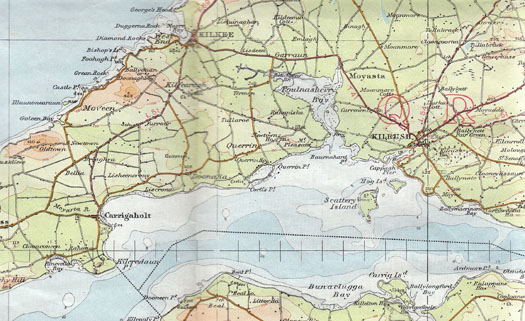
Querrin at the heart of things. Once you get west of Poulnasherry Bay, you're in the remote island-like atmosphere of the Loop Head Peninsula. Loop Head itself is another six miles west of the left edge of this map

Sally O'Keeffe provided a formidable design challenge for Myles Stapleton, as he had to create a roomy and high freeboard hull which still managed to incorporate elegant curves, yet all within an overall hull length of only 25ft. And of course, she had to sail very well too. Photo: W M Nixon
It was thought that the ribs of one of the old sailing workboats were sticking out of the mud at Blackwater Bridge on the road approaching Querrin from Moyasta. So as a local Querrin Sailing group began to gain traction, they got the notion of getting those last remains out of the mud, and restoring a proper Shannon Hooker to be the flagship of their little fleet, and the focus of a worthwhile community project in boat-building.
Perhaps it's as well the old wreck proved to be no more than shallow-water cot, for this seeming disappointment led eventually to designer Myles Stapleton and a magnificent but manageable project to build a new 25ft Shannon Hooker, using ancient photos and old drawings to re-create the best of the type.
In Querrin, Ned Griffin lent his fine shed up the hill for building the new boat, and as she took shape he also came up with the perfect name. In the 19th Century, Sally O'Keeffe had been the wife of a Querrin-based sailing workboat skipper, and she was a woman still remembered. It's a name of great style, but lest anyone think it's just too good to be true, let it be known that in 2012 as the new boat was making her debut, didn't Sally O'Keeffe's grandson – aged a hundred – return from America to give his blessing?
The building had started in 1910, and this Seol Sionna project drew on many sources and much voluntary labour, both within southwest Clare and further afield, to reach completion. They had the benefit of the extensive knowledge of traditional craftwork guru Cristoir Mac Carthaigh, who may be best known for his work in traditional boats, but if you've a bit of old-style thatching in mind, he can help you there too.
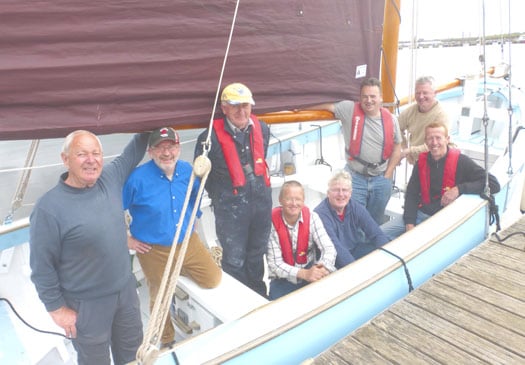
Some of the team at Querrin Sailing who built and sail the Sally O'Keeffe. Seen aboard on launching day at Kilrush are (left to right) Joe Hassett, Criostoir Mac Carthaigh, Michael O'Connell, Stephen Morris, Dixie Collins, Fintan Ryan, John Kennedy and Stephen Courage. Photo: W M Nixon

Steve Morris. Photo: W M Nixon
As for the building team, the trainee boatbuilders ranged in age from 16 to 80. It all became very possible thanks to Steve Morris, a fully-qualified New Zealand boatbuilder who came to Ireland a long time ago while taking a world backpack tour, and somehow stayed. He got involved in the building of the Jeannie Johnston on Tralee Bay in 1986, and for several years now he has lived near the shores of Poulnasherry Bay, and is a pillar of the maritime scene locally and nationally.
Steve served a full five year apprenticeship in boat-building in Auckland, so the community boat-builders of Querrin have had guidance and teaching of gold standard. In fact, thanks to Steve's input and the enormous goodwill and enthusiasm which the project engendered, it's doubtful if she could have been better built anywhere else in Ireland, while this video of him demonstrating caulking skills shows the standards to which they worked.
The ethos underlying the project has been eloquently articulated by Richard "Dixie" Collins, another of the key movers and shakers in Querrin Sailing:
"This is very much a community project from Loop Head peninsula. A keen, salty group who are sharing skills and enthusiasm for getting out on the ocean, to a place with a big sky and lots going on. There is training in seafaring skills for people who have never been out in a boat, and we provide trips to islands, and old piers which were built for boats like this in another time.
Our logo is taken from a gravestone in Scattery Island church of a boat-builder by the name of O'Mahony in 1832. In this small rural part of the western seaboard, we have built a sailing boat which we can maintain ourselves, and we offer sailing opportunities for everyone in the area for a five euro contribution to the club. An important outcome is the capacity building with new relationships, generational sharing of learning and having a right good time ourselves. It strengthens our sense of community, and is a shared credit to the collective efforts of everyone."
Despite the robust hull's obvious sailing power, Sally O'Keeffe needs only one hand on the tiller.
As the Sally O'Keeffe was going to be kept undecked with her hull limited to 25ft overall, for safety reasons they had to ask Myles Stapleton to give her quite high freeboard. It says everything about his skills as a creator of good-looking boats that despite the high freeboard – which has proven a Godsend in both the Estuary and on some remarkable and swift coastal passages on the open Atlantic north to Galway and south to Baltimore – the Sally O'Keeffe has a tremendously vigorous style to her appearance. It lifts the spirits just to see the sweep of her sheer and the elegant way in which the transom stern is incorporated in a sweet yet powerful run aft.
In 2013 she sailed forth more than seventy times, and while the highlights were the voyages to Galway and Baltimore, the essence of her popularity is the shorter jaunts within the Estuary, captured very effectively on this brief video by John Collins taken aboard after overnighting with a camp on Canon Island.
Despite a tiller of only average length, she is easily steered – in fact, "finger-tip control" is the theme of much of her sailing. As for her speed, it has pleasantly surprised everyone involved, and the visit to Baltimore found the little 25-footer from the Shannon pacing with or even over-taking the 33ft mackerel yawls from West Cork.
The Baltimore Wooden Boat Festival (this year's is from 23rd-25th May) is the gathering of the crème de la crème of Ireland's wooden boatbuilders. The very fact that they can be up and running so early in the season is proof they're the tops, but as the Baltimore maritime calendar is so full of events, this is when the timber tribe has to take to the seas, even if many older wooden boats elsewhere in Ireland seldom put a toe out until June.

At the Baltimore Wooden Boat Festival 2013, Sally O'Keeffe found herself pacing with the larger 33ft West Cork mackerel yawl

Baltimore Wooden Boat Festival gathers the crème de la crème of the traditional and classic boat-building brotherhood. This is Rui Ferreira of Ballydehob sailing the Castlehaven Ette Class dinghy which he built, with Sally O'Keeffe in the background making her Baltimore Debut
Meanwhile, nearer home, Querrin Regatta is today. That's right, Saturday May 10th. Unfortunately the weather prospects aren't great, with the jet stream squatting over Ireland like some vast demented dragon. But at least the Sally O'Keeffe is in proper order, as she demonstrated during some heavy weather sailing in the Estuary on Bank Holiday Monday. And the famous West Clare racing currachs are up for it too – last Sunday we saw one of the renowned Doonbeg racing currachs in intensive training off their little port, where the inner reaches now have a handy pontoon in a pool in the river.
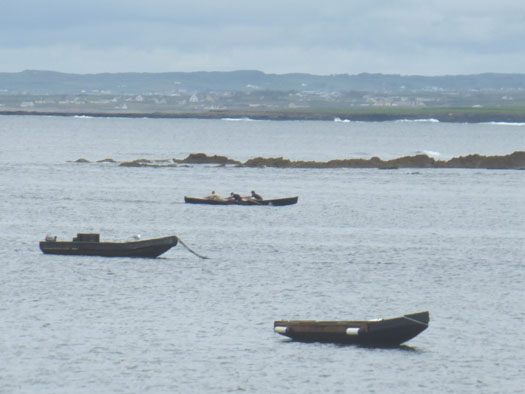
The western way. Racing currach at Doonbeg in training on Sunday morning. Photo: W M Nixon
One local boat which definitely won't be at today's Querrin Regatta is the reason we ended up in Kilrush in the first place. This is Steve Morris's own special pet, and it was Kim Roberts of Askeaton who suggested that this was worth seeing. It certainly is. He has taken a classic Harrison Butler Khamseen design, which is remarkably like an anticipation of Lyle Hess designs like Fred Schotman's Raven from the Netherlands which was in Dublin Bay last year, and is creating his dreamship at home.
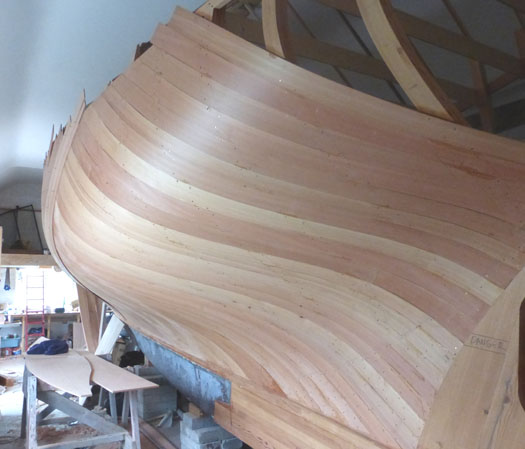
The port side of Steve Morris's 31ft Harrison Butler design looking forward, with the rich texture of the Alpine larch glowing through. Photo: W. M. Nixon
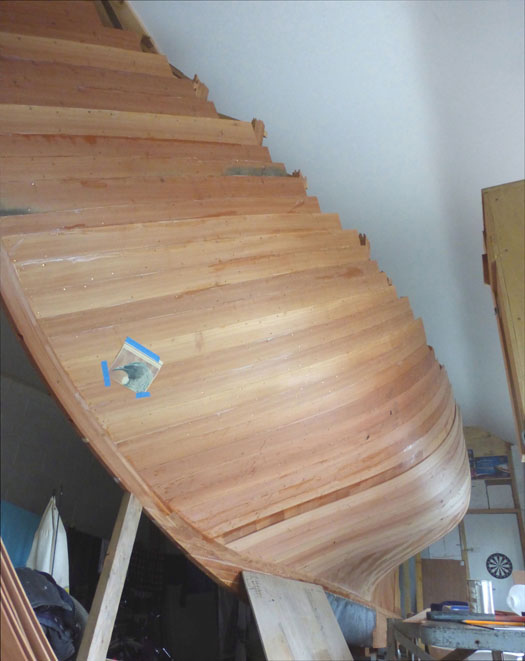
Don't try this at home.....Steve Morris has managed to fit this 31ft hull into the garage beside his house. Photo: W M Nixon
Steve is building this honey of a boat in multi-skin, using dark dense Alpine larch, the leftovers of a consignment of timber which was brought in from Austria for the building of Jeanie Johnston. The man works so neatly that he has managed to fit the entire project into the admittedly spacious garage beside his house near Moyasta, and the workshop is one of those spiritually-enhancing places which are a balm for the soul.
Particularly impressive is the perfectly-shaped lead ballast keel which fits so well into Harrison Butler's flowing lines. And it's typical of this job too. For when I asked him who made the form and cast the keel for him, he was surprised by the question, as the answer simply is: "I did it myself, right here on site".
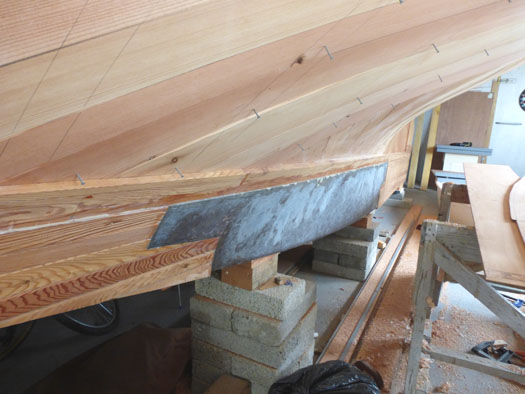
"No problem". The lead ballast keel was cast on site. Photo: W M Nixon
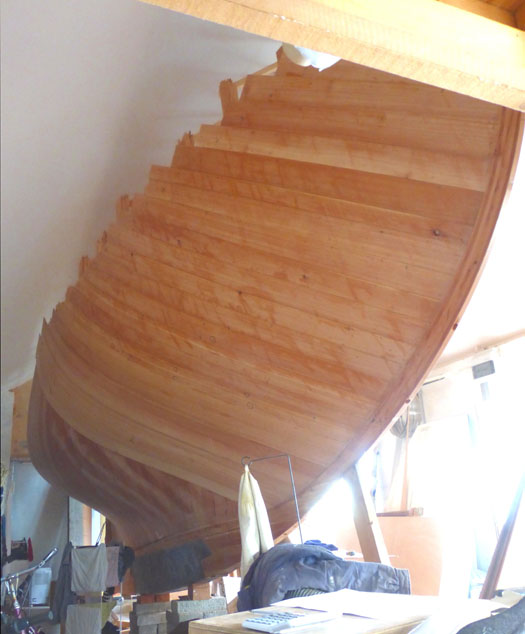
Even with quite a large garage, it's very difficult to get a photo showing all of a 31ft boat. Starboard side looking aft. Photo: W M Nixon
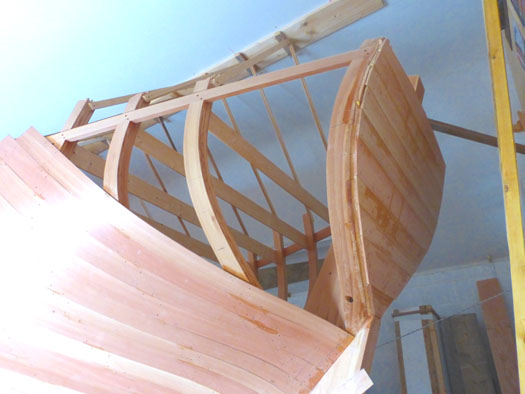
Although the Metacentric Shelf theory of hull design to which Harrison Butler subscribed has been large disproved, he still produced hulls of balanced performance with transom sterns which didn't drag half the ocean after them. Photo: W M Nixon

A dartboard is an essential in any boatbuilding shed. You need something to keep you well away from the job while glue is setting. Photo: W M Nixon
Using "leftover" timber for boat-building projects is an appropriate theme as we emerge from recessionary times. After John Kearon and his team had made such a fine job of conserving Asgard, there were bits and pieces of well-seasoned leftover wood, and they provided enough timber for Pat Murphy and his group of support volunteers to put in train the building of a replica of Asgard's original 1905 10ft dinghy, designed by Colin Archer himself.
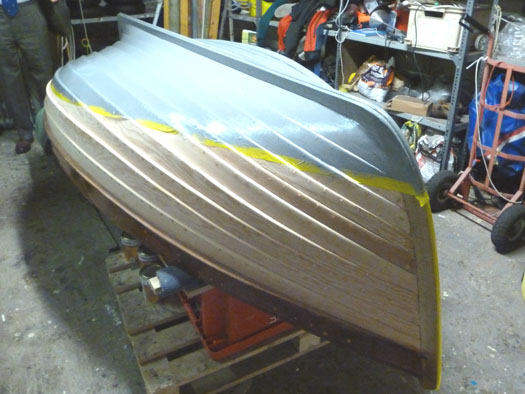
Asgard's dinghy starts to get the finishing treatment. Photo: W M Nixon
It was Fingal boatbuilder Larry Archer (absolutely no relation to the great designer, we're told) who put the little boat together. Like Myles Stapleton when he was tidying up the original drawings of Asgard's lines for a book two decades ago, Larry was very impressed with the way Archer's mind worked, as he designed the transom of the little boat to sit clear of the water when carrying a normal load, thus enabling her to slip easily along without leaving a wake like the inside of a washing machine.

Pat Murphy with Asgard's dinghy. After leading the creation of this little beauty, he understandably has mixed feels about putting her in rugged salt water. Photo: W M Nixon
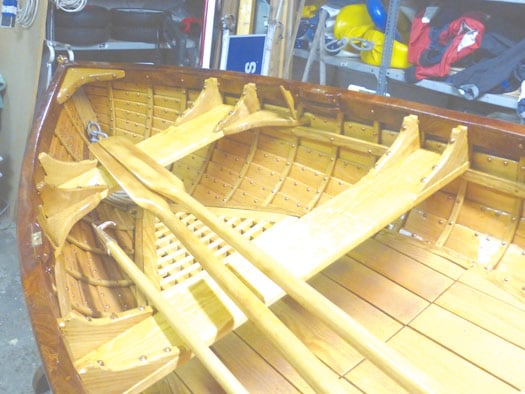
Classic construction and finish detail up forward. Photo: W M Nixon

The interior in the stern – for a ten footer, she is remarkably detailed, particularly where the required twist is put into the planking to maintain a sweet run aft. Photo: W M Nixon
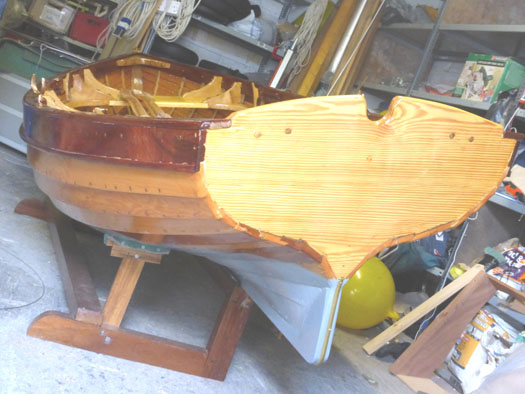
With a clever design to keep the transom clear of the water when the boat is carrying a normal load, Colin Archer created an easily driven yet workmanlike hull. Photo: W M Nixon
It's a remarkable bit of boat design, but with the dry timber it was the very devil to build in the necessary twists.. However, it was done in the end, and the new boat emerged in all her glory, exquisitely finished in classic varnishwork by Pat Murphy and George Elliott, with Neville Maguire making an impressive job of restoring an old set of oars to match the style.
Public debut – Agard's dinghy at Howth Prawn Festival. Photo: Pat Murphy
Asgard's dinghy made her public debut at the Howth Prawn Festival a fortnight ago, and was a star of the show. But the trouble is that when you get a boat finished to this standard, the very thought of putting her into rugged salt water is not appealing. Pat and his team accept the fact that the Asgard dinghy will have to go afloat for the Erskine & Molly Childers Asgard Centenary at Howth on Sunday July 27th. But for now they're much happier just admiring this gem as she shines in the shed, safe from the sea. And who can blame them?
#historicboats – Boat-building organisations from France, Spain and Belgium and boating enthusiasts from across Ireland will attend an EU backed workshop conference as part of a three day visit to Cork Harbour next week.
The host organisation Meitheal Mara, based at Crosses Green in the heart of Cork City, is a community boatyard that, through its training programmes, utilises traditional boatbuilding, wood working and rowing skills to promote participant's social and personal development.
The EU Boat project is a three year learning partnership connecting Meitheal Mara with similar organisations from across Europe to share good practice, discuss challenges and devise solutions.
In addition to connecting community boat-builders, the project will also provide an opportunity for public representatives to come together to discuss their strategies for developing recreational water activities, preserving maritime heritage and promoting harbours and waterways for tourism. This week will see representatives from Cork City Council, Port of Cork and Failte Ireland come together with their European counterparts who are also travelling to Cork for the event.
The European visitors will also get the chance to try their hand at rowing a traditional Irish currach on the river Lee, visit the Port of Cork and tour the bonded warehouses on Custom House Quay.
Ireland's West Coast – Special Boats & Big Hearted Sailors
#historicboats – These days we're told of the growing disparity between the economic recovery of Ireland's eastern region, and the relative economic stagnation of some of the rest of the country. But W M Nixon suggests that, for one part of the western seaboard at least, there's a special vitality to life around boats which challenges this perception, and could usefully be emulated elsewhere. And he signs off with a thought-provoking conclusion.
Connemara, Conamara. Spell it as you wish, but The Land of the Sea on Connacht's most westerly coast fires the imagination and inspires the spirit. It's a place of the mind as much as a place of wild mountains where rocky inlets wind their way deep into rugged country. So while purists might define it exclusively as the much intertwined coastline with its myriad islands between Spiddal and Killary, many of the rest of us can be so inspired by that special Connemara quality that we reckon it runs all the way from Galway Bay to Achill. And anyone from that magic coastline, or indeed anyone who has been inspired by it, carries the spirit of Connemara with them wherever they may be.
The boat people you meet out there, each with their own unique and often ambitious maritime agenda, will send you on your way re-enthused about boats and places and their many possibilities. And when someone from another place or indeed another country decides that it's in Connemara their true self and fulfilment is to be found, far from being seen as exiles they are instead seen as a new focal points for their old groups, and their soul-mates from times past descend on them in Connemara for inspiration and mental re-birth.
This weekend, the boat men from Clondalkin in outer Dublin are journeying to Renvyle on the furthest far west coast to help one of their own in his boat restoration programme at a storm-battered corner on a bit of coast which was almost washed away in the winter's seemingly endless climatic violence.
The men of Clondalkin are the community group who built and sail and continue to lovingly maintain the large Galway Hooker Naomh Cronan. Recently, they've been busy enough with replacing some planks on their hefty big boat. But their key organiser Paul Keogh is mindful of the fact that one of their own, Paddy Murphy, is in the west, living on an Atlantic point out beyond the old Oliver St John Gogarty house which is now the hotel at Renvyle.
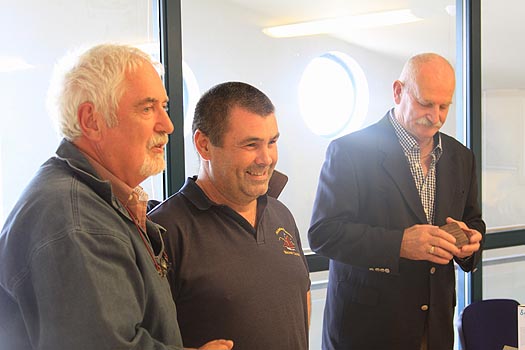
They dreamed the dream, and they made it happen. Key movers in the Naomh Cronan story were Stiophan O Laoire (left) and Paul Keogh, seen here at Poolbeg Y & BC as they come forward to accept a prize on behalf of the crew from Johnny Wedick, Hon. Sec. of the Dublin Bay OGA. Photo: Dave Owens
And between Paddy's house and the sea, beside a little hidden slipway which serves small boats which undertake the risky but rewarding challenge of harvesting Ireland's most fish-filled waters, the restoration project on the Aigh Vie is proving to be a demanding task. So this weekend the Keogh team – precise numbers unknown until everyone checks in this morning – are on site to re-caulk the Aigh Vie in a wild weekend of communal energy.
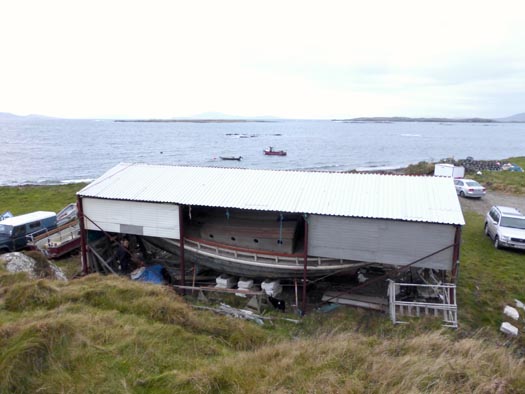
On the Atlantic frontier at Renvyle, the Aigh Vie is under her roof, tilted over to port to facilitate work under the starboard side of the hull. Photo: W M Nixon
For the Aigh Vie is one very special vessel. She's one of the Manx fishing nobbies which reached their ultimate state of development in the first twenty years of the 20th Century before steam power and then diesel engines took over. The nobby evolved to an almost yacht-like form through vessels like the 43ft White Heather (1904), which is owned and sailed under original-style standing lug rig by Mike Clark in the Isle of Man, and the 1910 Vervine Blossom, now based in Kinvara, which was restored by Mick Hunt of Howth, but he gave her a more easily-handled gaff ketch rig which looked very well indeed when she sailed in the Vigo to Dublin Tall Ships Race in 1998.
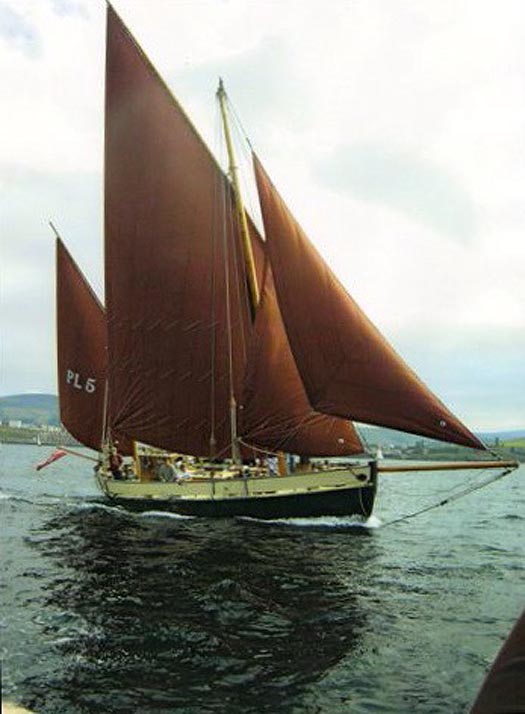
Mike Clark's Isle of Man-based 1904-built Manx nobby White Heather sets the original standing lug rig.
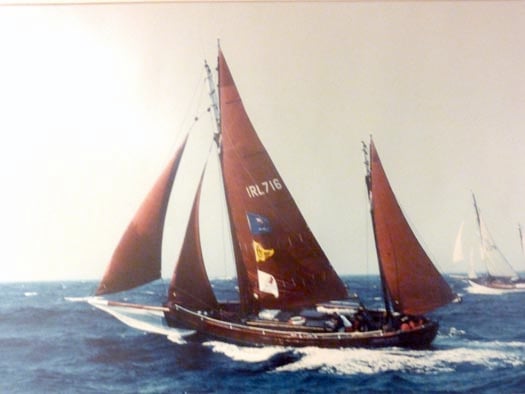
The 1910-built Manx nobby Vervine Blossom was restored by Mick Hunt in Howth, and is seen her making knots under her gaff ketch rig at the start of the 1998 Tall Ships Race from Vigo to Dublin. Photo: David Branigan
It takes quite something to outdo the provenance of these two fine vessels, but the story of Aigh Vie (it means a sort of mix of "good luck" and "fair winds" in Manx) is astonishing. It goes back to the sinking of the Lusitania by a German U Boat off the Cork coast in May 1915, when the first boat to mount a rescue was the Manx fishing ketch Wanderer from Peel, her crew of seven skippered by the 58-year-old William Ball.
They came upon a scene of developing carnage. Yet somehow, the little Wanderer managed to haul aboard and find space for 160 survivors, and provide them with succour and shelter as they made for port. In due course, as the enormity of the incident became clear, the achievement of the Wanderer's crew was to be recognised with a special medal presentation. And then William Ball, who had been an employee of the Wanderer's owner, received word that funds had been lodged with a lawyer in Peel on behalf of one of the American survivors he'd rescued. The money was to be used to underwrite the building of his own fishing boat, to be built in Peel to his personal specifications, and the result was his dreamship, the Aigh Vie, launched in 1916.
Over the years, the Aigh Vie became a much-loved feature of the Irish Sea fishing fleet. Tim Magennis, current President of the Dublin Bay Old Gaffers Association, well remembers her from his boyhood days in the fishing port of Ardglass on the County Down coast. In time, she was bought by the legendary Billy Smyth of Whiterock Boatyard in Strangford Lough, who gradually converted her to a Bermudan-rigged cruising ketch with a sheltering wheelhouse which enabled the Smyth family to make some notable cruises whatever the weather. His son Kenny Smyth, who now runs the boatyard with his brothers and is himself an ace helm in the local 29ft River Class, recalls that the seafaring Smyth family thought nothing of taking the Aigh Vie to the Orkneys at a time when the average Strangford Lough cruiser thought Tobermory the limit of reasonable ambitions.

Aigh Vie as she was when bought by Paddy Murphy from Billy Smyth of Strangford Lough.
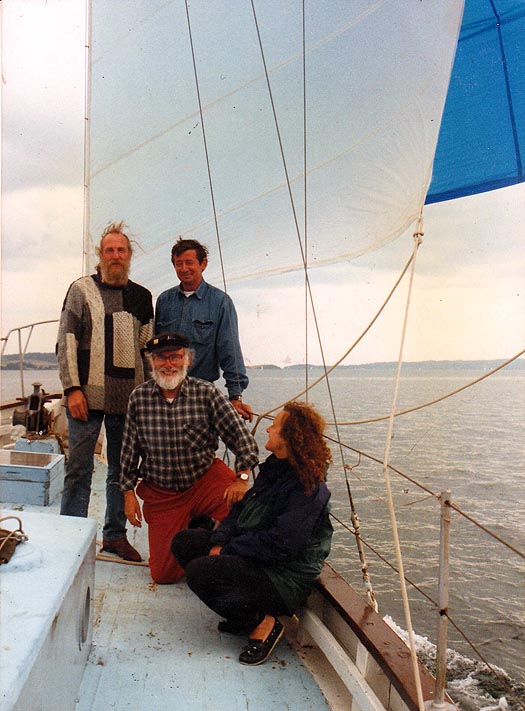
First sail with the newly-bought ship. Aboard Aig Vie heading for Dublin down Strangford Lough, the crew includes Paddy Murphy (left) and Tim Magennis (centre)
It's some years now since Paddy Murphy bought the Aigh Vie, and sailed her back to Dublin with his crew including Tim Magennis. But around the same time, Paddy was moving his base west to Renvyle, where he reckoned his skilled trade as a blacksmith, and his talents in traditional music and folklore, would provide him with a living in the area where he felt most at home.
As for the Aigh Vie, clearly she was reaching an age where work needed to be done. And he was minded to restore her to something more nearly approaching her original 1916 configuration. So somehow or other, he took the big boat west on a truck, managing to negotiate those little winding roads through Tully Cross and down to his place by the sea, where she went under a roof and work began.
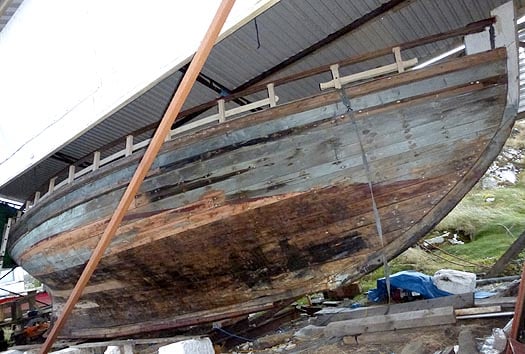
The hull of the 1916-built Aigh Vie as seen in Renvyle shows the remarkably yacht-like lines of the Manx nobby.........Photo: W M Nixon

.........in what was one of the last of the sailing type to be built before steam power took over. Photo: W M Nixon
It has been going on for some time now. The problem with being right on the frontier of Ireland's Atlantic weather is that no sooner do you start on some new area of timber repair and replacement, than the previous restoration section almost immediately starts to become weathered. Working largely on your own, you end up feeling you're going round in circles. So that's why the men from the Naomh Chronan are in Renvyle today to give the Aigh Vie project a mighty push forward.
For there's no doubt that while there's a lot done, there's a lot more still to do. But it does get done eventually if you keep the faith, and I was there back at the beginning of December to cheer Paddy along with all the usefulness of a hurler on the ditch. But at least I was accompanied by Dickie Gomes, who knows a thing or two about long-term boat restoration, as it took him 27 years to bring his 102-year-old Ainmara successfully back to life. But he did it so well that she won the Creek Inn Trophy for "Best in Show" at last summer's Peel Traditional Boat Weekend in the Isle of Man.

A bit of mutual support between two owners of vintage wooden boats – Paddy Murphy and Dickie Gomes in Aigh Vie's shed at Renvyle. Photo: W M Nixon
Nevertheless I've to confess that sometimes I wonder if wood is worth the trouble. Before getting to Renvyle, we'd called by with Jamie Young at Killary Adventure Centre for bit of a love-in with his alloy-built Frers 49 Killary Flyer which - as Brian Buchanan's Hesperia IV - was winner of the Round Ireland Race 1988 under the command of Dickie Gomes. Except that you won't see that fact in histories of the Round Ireland. Because for 1988's race, she sailed as the sponsored entry Woodchester Challenger, and thus was not entitled to the top prize, despite having the best corrected IOR time in the fleet.
But everyone in the know knows that Gomesie won, particularly the crew of Denis Doyle's slightly larger Frers sloop Moonduster. The two boats had been neck and neck running past the Blaskets, and suddenly Hesperia's spinnaker shredded. But Dickie had his crew so well drilled that one half of them had a replacement chute up and drawing before the other half had finished getting in the remains of the torn sail. The boat scarcely missed a beat in her rapid progress, and when the whole business was completed in about three minutes flat, there was a round of applause from Moonduster. You'd sportsmen doing the Round Ireland in those days.
As it happens, one of Hesperia's crew for that neat bit of work was Kenny Smyth, so it made it more than appropriate that we were going on to see the Aigh Vie on which he cut his offshore sailing teeth. But it was good to linger for a while at Jamie's snug place, and marvel at how he, with aid from the ingenious folk of the west, had contrived a slip and an angled trolley so that Killary Flyer can be hauled on site into a sheltered corner, for she's a big lump of a boat to be handling ashore.
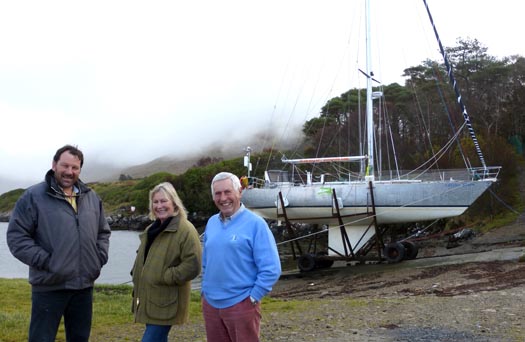
She's a big boat to be hauling on a slip in a remote corner of Mayo. Early December beside Killary Fjord, and Jamie Young of the Adventure Centre with Deirdre and Dickie Gomes and the Frers 49 Killary Flyer ashore for the winter. Deirdre was a fulltime member of the boat's crew when Dickie successfully skippered her offshore as Brian Buchanan's Hesperia IV. Photo: W M Nixon
It was some time in the New Year that we heard the shocking news. One of the most severe storms had twirled the Flyer up like a toy boat from her sheltered corner, and deposited this Frers masterpiece on her ear. Jammed in against the steep shore, she was trapped as the tide came in, and the hull was flooded with severe damage to the electrics and electronics.
But this is the west, where they're accustomed to overcoming massive challenges. The extraordinary Tom Moran of Clew Bay Boats played a key role in a salvage project which saw a temporary road being built so that a giant crane could be positioned for the delicate job of inching the big boat back upright. That done, she could then be moved to Tom's place at Westport for restoration to begin.
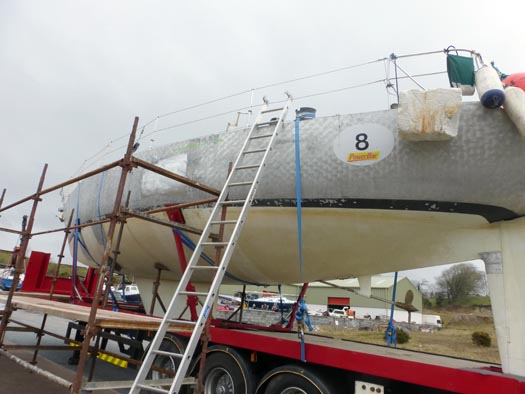
A couple of dents in aluminium? No problem. Following her brief episode of aviation, Killary Flyer's hull is already made good at Clew Bay Boats in Westport. Photo: W M Nixon
The whole business has been a marvellous advertisement for the effectiveness of hull construction using modern marine alloys. When aluminium was first created as the "Metal of the Future" two centuries ago, only the Emperor Napoleon could afford to have a cutlery set made in this exotic stuff. And though an early alloy boat put afloat in Lake Geneva performed reasonably well, as soon as a boat built with it was put into the salty sea, it just melted away.
But over the years the formulas have been adjusted to be corrosion proof in sea water, such that nowadays it's the ideal material for little boats which are going to have hard usage yet little maintenance, such as angling boats and the nippy craft used by rowing coaches.
And if you have a low-maintenance alloy hull yet give it a bit of cosmetic attention, it will look very well indeed, but it's not essential. As for the rough and tumble of life afloat, if you crash into a quay wall with a traditionally built wooden boat, she'll become shook from bow to stern – you never really know where the underlying structural damage ends, if at all. As for GRP and carbon or whatever, the damage will be more localised, but it still gets holed, and messily with it at that, while bulkheads may shift to an unknown degree
But a steel or aluminium hull will generally just be dented, and very locally at that. Repairs are manageable, even if it's skilled specialist work. So there's a lot in favour of steel and alloy. But steel rusts, and it never rusts quicker than in hidden pockets in the structure. But with remarkable advances in alloy welding and building techniques, the advantages of modern corrosion-free alloy construction become more evident every year for boats that are really going to be used, and not just seen as marina ornaments.
The Killary Flyer experience is ultimately a telling argument in favour of alloy construction. The hull was only dented in a couple of places where it was actually in direct contact with outcrops on the foreshore. Any dents have already been repaired by Tom Moran and his team, for they're able for anything to do with boats in any sort of material - I reckon if you wanted to build your dreamship out of resinated peat moss, then Tom would be game for the job.

Can-do people of the west – Mary and Tom Moran of Clew Bay Boats have successfully taken on many marine problems and projects. Photo: W M Nixon
Sorting out the interior systems is going to be more of a challenge, for Hesperia was originally Noryema X, built for Ron Amey in 1975. In a sense, there's a feeling of homecoming in the fact that she's being restored in Westport. If you head directly inland from that lovely little town, you're soon up in the mountains in the Joyce Country. And way back in 1975, the alloy hull of Noryema X was built by the renowned Joyce Brothers. Their fabrication workshop may have been in Southampton, but the family wasn't that long out of the mountains of far Mayo.
However, once the innovative Ron Amey had taken delivery of the hull of his latest Noryema from the brothers Joyce, he then took it to Moody's big shed at Bursledon on the Hamble for completion by the boatyard's craftsmen. I happened to be Bursledon-based in the early summer of 1975, and it really was all a wonder to behold.
Amey had installed a caravan in Moody's shed, and he lived in it while overseeing every detail of the new boat's fitout, while at the same time running his business empire of Amey Roadstone from a telephone in the caravan. It was said that the great man wouldn't be really happy with his new boats until the final jobs were completed just before the Fastnet Race in August, and after that he'd then start to think of the next one. But Noryema X was something special. She became the last of the racing line, and despite her enormous rig, Ron Amey then used her for eleven years of cruising in the Mediterranean which concluded with her sale to Brian Buchanan of Belfast Lough at Marseilles in 1986. She has been based on our island ever since, the source of much seagoing pleasure for hundreds of Irish sailors.
So bringing her back up to Amey standards is quite a challenge, as she's now part of Ireland's sailing heritage. But with Tom Moran they've someone who seems to have links with every maritime specialist in the country, and if he draws a blank in Ireland, his connections around the Solent marine industry seem pretty hot too.

Not quite where you'd expect to find an Arctic voyaging vessel, but Northabout seems at home in the Moylure Canal in the midst off Mayo fields. Photo: W M Nixon
Much encouraged by all this, for Clew Bay Boats is the sort of place where many good things seem possible, we then headed down to the Moylure Canal, a drainage waterway near Rosmoney at the head of Clew Bay where the great Jarlath Cunnane has created a tiny boat harbour and beside it a little place where, if so minded, he can build himself a boat.
Jarlath is the quintessential Connacht mariner, yet you'll never find him being sentimental about wooden boats. On the contrary, in the time I've known him he has built himself a steel van de Stadt 34ft sloop which he cruised very extensively, and more recently he took on the challenge of alloy construction to build the 44ft Northabout. Aboard this special boat, in teamwork with Paddy Barry, he has made cruises to remote and challenging places in voyages which, for most people, would have required full military logistical support.
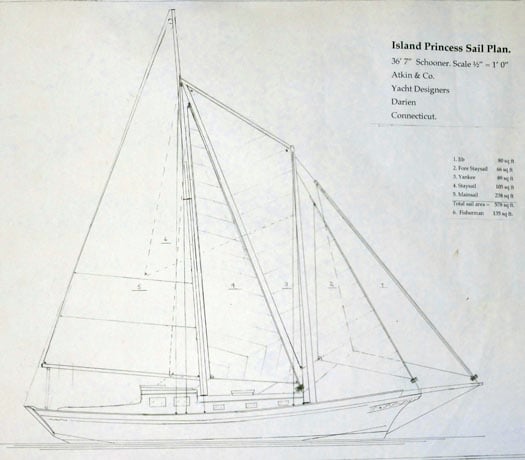
The new dreamship. Plans of the 37ft Atkins schooner which Jarlath Cunnane has been building over four years.
Knowing the scale of what he has done with her, it was bizarre to see Northabout sitting modestly in her berth in the little creek beside a Mayo field. But the presence of the long distance high latitude voyager was only part of the Moylure package. A few feet away in "the shed which isn't really a shed" was the new Cunnane boat, a sweet 37ft–Atkins schooner which, if you haven't yet appreciated the potential of good alloy boat construction, would surely win you over in a trice.

Good alloy construction, as seen here in the stemhead of the new schooner, can withstand comparison with any material. Photo: W M Nixon
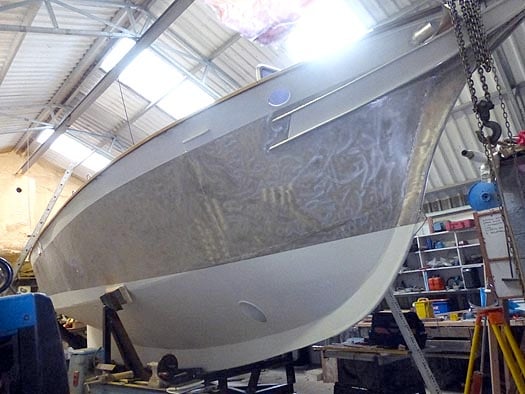
The new schooner has a workmanlike and handsome hull......Photo: W M Nixon

....which is aimed for comfort as much as speed, but she should be able to give a good account of herself in performance, and will be very comfortable for longterm periods on board. Photo: W M Nixon
Jarlath has taken four years on the construction, and when he gets to sailing the new boat, I'd say that the motto will be: "When God made time, he made a lot of it". This is a boat for leisurely cruising, a boat to enjoy simply being on board. In her finished state, she'll give little enough in the way of clues as to her basic construction material. Like Killary Flyer, and like Northabout too, she is in her own way a great advertisement for the potential of good alloy construction.
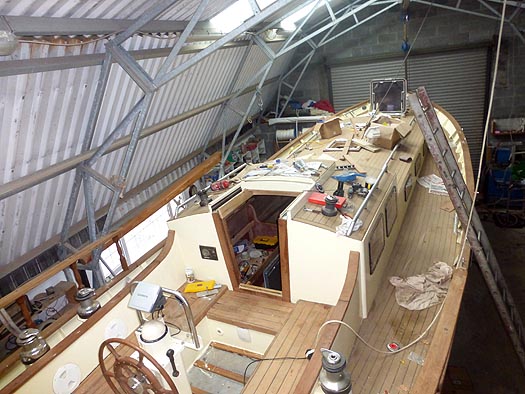
As completion nears, it becomes ever less apparent......Photo: W M Nixon
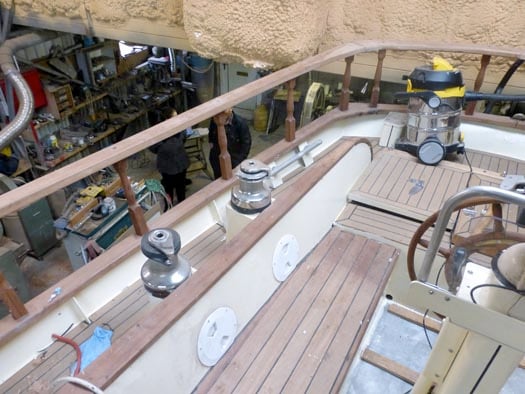
.....that the hull construction of the new schoner is in aluminium. Photo: W M Nixon
So we'll sign off this week with a special thought. As Irish life begins to move again, doubtless we'll soon hear increasing mutterings about the desirability of building a new Asgard sail training brigantine. Maybe we should keep the government out of it this time round, and build her through a voluntary trust organisation supported by public subscriptions and corporate donations. But however it's to be done, we should be starting to think about it.
And like many others, I've long thought that the ideal way forward would be with a steel hull built to Jack Tyrell's original Asgard II lines, which have a magnificently timeless quality to them. But I've changed my mind on that. Having seen what can be done with good alloy construction down in Mayo, and knowing the quality of alloy workboat construction being produced by firms like Mevagh Boatyard in Donegal and by the descendants of Jack Tyrrell among others at Arklow Marine Services in County Wicklow, it's difficult to escape the conclusion that the hull of the new ship should be built in aluminium.
It would be initially expensive, but it would confer great longterm maintenance advantages. And by going that way, we'd be able to provide all the double skins and safety bulkheads which will now be required without using up all available hull space, and without producing a boat so heavy she wouldn't be able to sail out of her own way. So let's hear it for an aluminium-hulled Asgard III.
Bronze Age Boat Is Afloat!
#BronzeAgeBoat - After nearly a year of hard work by a team of volunteers in Cornwall, a pioneering heritage project to recreate an ocean-going boat from the Bronze Age finally saw its results take to the water recently.
The 50ft long, five-tonne vessel was crafted out of two giant oak logs using the tools and methods that the first boat builders would have had to hand some 4,000 years ago.
“It has been incredible to see this whole project take shape in the Museum building over the past 11 months," said Andy Wyke of the National Maritime Museum Cornwall.
Volunteers led by shipwright Brian Cumby worked in collaboration with leading Bronze Age boat expert Prof Robert Van de Noort and his colleagues at the University of Exeter to produce the finished article, which was successfully paddled in Falmouth Harbour much to everyone's delight and relief.
“There have been doubters, professionally, who questioned the feasibility of this vessel crossing the seas," said Prof Van de Noort. "This project has proven that it was possible.”
The boat is now on display at the museum's pontoon in Falmouth.
Meitheal Mara’s ‘Boatyard Open Day’
Topics will be on classic and traditional boat repair, restoration and build boatbuilding and lofting to varnish and tarring. The exhibition will feature slideshows and a boat display of a folk boat, Crosshaven clinker rowing punt, thullier sailing clinker punt, Valentia carvel seine boat follower, Rinn Rua, pram dinghies, currachs and canoes.
Also on hand will be Siubhán McCarthy who will be talking about the 'Ocean to City' race and what's happening in Cork harbour. For information contact Meitheal Mara Tel: (021) 4316813 or [email protected]





























